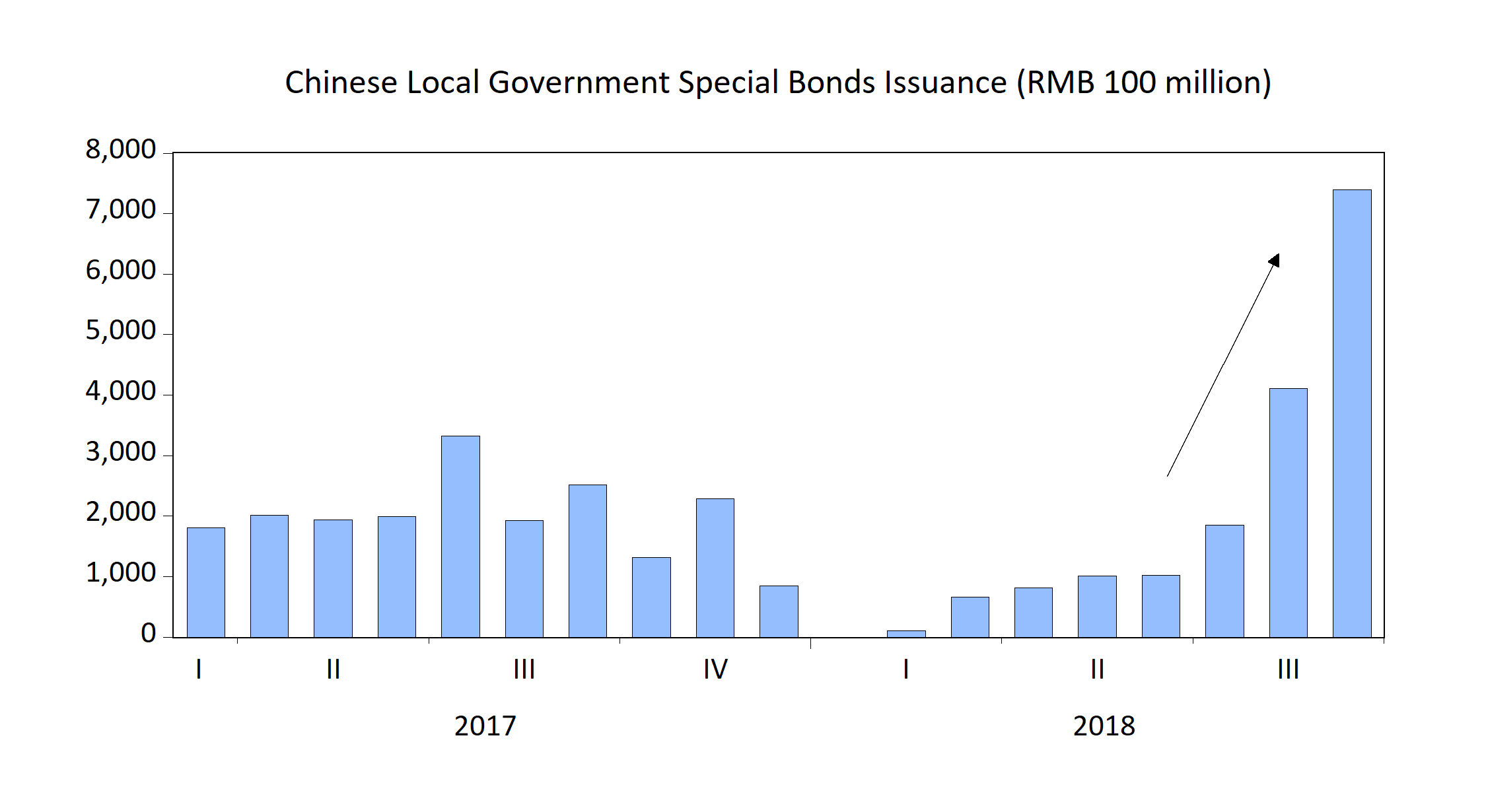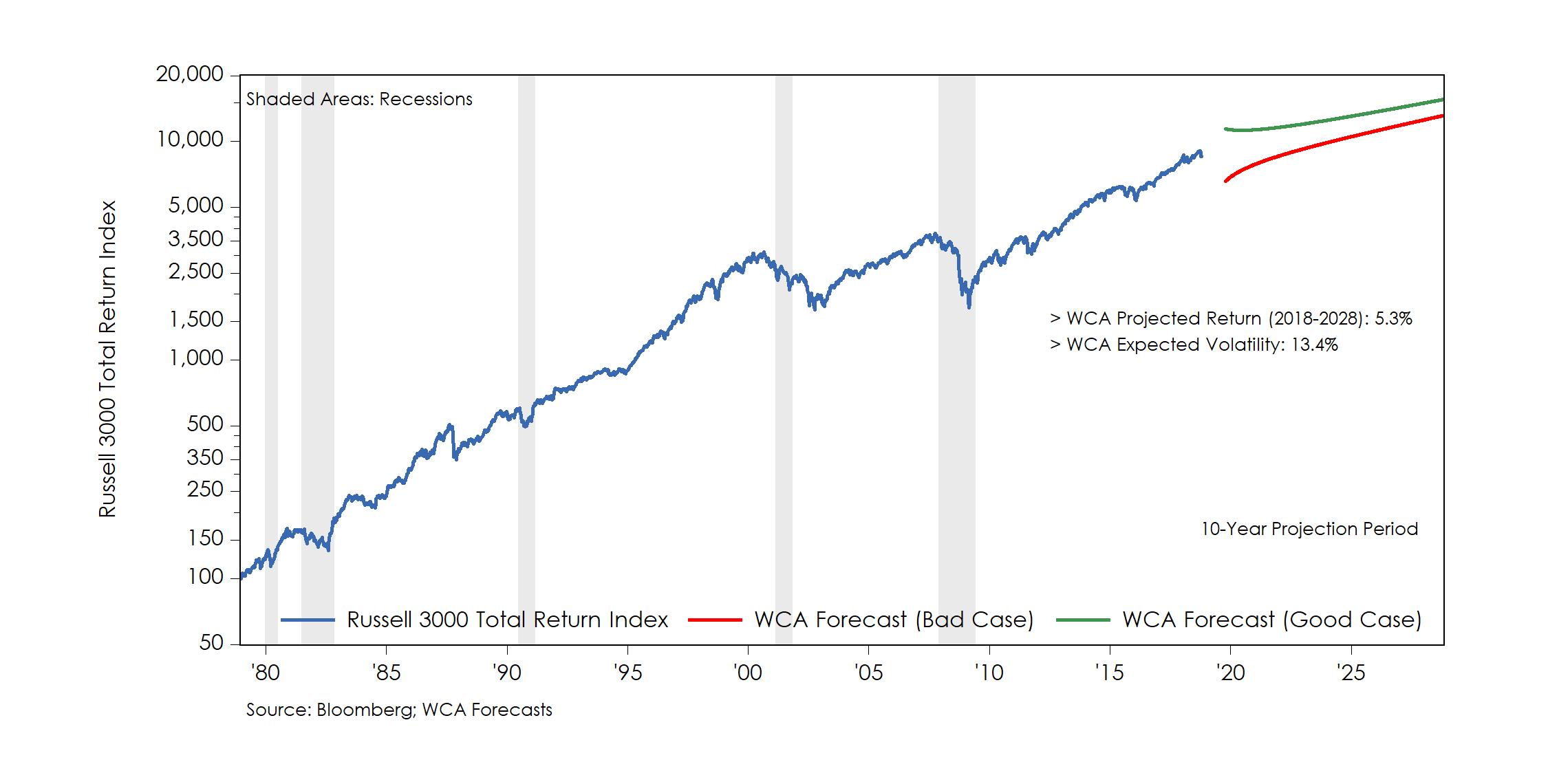Monday Morning Minute ~ October 22, 2018
China has been a major contributor to the global growth story in recent years, and has had a big impact on developments in foreign and emerging markets. As we’ve noted in previous commentary, we have been seeing some weakening in growth outside the United States while growth here remains strong. A 30% drop in the Chinese stock market, a sharp reversal in the Chinese currency, and slowing output growth all point to accumulating foreign sector weakness. Within China, the Chinese government has increased stimulus as evidenced by a recent surge in local government bond issuance (chart, below), and the Peoples Bank of China (PBOC) has responded by cutting the amount of cash banks must hold as reserves. In a recent interview, PBOC Governor Yi Gang affirmed his belief that China’s fundamentals were “sound” and laid out a series of steps being taken to provide liquidity to the real economy. These steps include local government and central bank aid in funding local business, and PBOC support aimed at encouraging more business loans throughout China’s banking system. We are yet to see the impact of these measures given recent soft reports on output and industrial production.

Where Next?
We continue to see this year as a transition year with divergent paths emerging in different parts of the world. Most global equity markets, by and large, are solidly negative for the year measured either in local currency or dollar terms, but our markets are hanging on to small gains. Compared to the struggles of the rest of the world, the United States continues to experience good growth, low unemployment, firming inflation, and rising interest rates. An important question from here is whether or not the United States can continue to go its own way without the support of positive momentum among our major trading partners.
The chart below provides some visual sense of what a “bull” and “bear” case might look like for the U.S. equity market in the context of our current long-run return and risk assumptions. Under our current return and volatility assumptions, we envision a long-run, projected “base case” total return for United States equity markets of about 5.25%. A better and more accurate depiction of this forecast should capture some measure of uncertainty. The chart below attempts to incorporate such a range of outcomes, by incorporating historical risk measures around our “base case” 5.25% long-run equity market return projection. In this case, we think a -22% downside in a “bear” case and a +33% upside in a strong “bull” case are both within the realm of possibility over the short-to-intermediate term. Moreover, these are simply our estimates and it is important to recognize that actual outcomes could differ materially from these or any such forecast. However, we believe that it is helpful to consider a range of potential outcomes, if only to avoid complacent and biased thinking.
Importantly, we would not be surprised to see three things emerging in the future. First, we expect stock returns to be lower than in the past. Second, we expect stock returns to outpace cash and bond returns over the long haul (10-15 years). Third, we expect to see an increase in volatility from exceptionally low levels, especially as interest rates rise toward levels no longer seen as “accommodative.”
WCA Long-Run Equity Return Projection

Looking Ahead
Beginning this month, we are moving our monthly updates to the WCA Fundamental Conditions Barometer to the start of each month from the middle of each month. When updated, we anticipate continued strong showing from domestic economic data, coupled with weaker trends outside our borders, to keep our barometer reading near the middle of the range. Moreover, the recent pickup in market volatility could also produce some near-term headwinds for the barometer as we move toward year-end.
For now, we remain with our key tactical calls which are summarized in our latest Q4 Tactical Asset Allocation quarterly report.
Kevin Caron, CFA, Senior Portfolio Manager
Chad Morganlander, Senior Portfolio Manager
Matthew Battipaglia, Portfolio Manager
Suzanne Ashley, Analyst
973-549-4168
www.washingtoncrossingadvisors.com
www.stifel.com
Disclosures
WCA Fundamental Conditions Barometer Description: We regularly assess changes in fundamental conditions to help guide near-term asset allocation decisions. The analysis incorporates approximately 30 forward-looking indicators in categories ranging from Credit and Capital Markets to U.S. Economic Conditions and Foreign Conditions. From each category of data, we create three diffusion-style sub-indices that measure the trends in the underlying data. Sustained improvement that is spread across a wide variety of observations will produce index readings above 50 (potentially favoring stocks), while readings below 50 would indicate potential deterioration (potentially favoring bonds). The WCA Fundamental Conditions Index combines the three underlying categories into a single summary measure. This measure can be thought of as a “barometer” for changes in fundamental conditions.
The information contained herein has been prepared from sources believed to be reliable but is not guaranteed by us and is not a complete summary or statement of all available data, nor is it considered an offer to buy or sell any securities referred to herein. Opinions expressed are subject to change without notice and do not take into account the particular investment objectives, financial situation, or needs of individual investors. There is no guarantee that the figures or opinions forecasted in this report will be realized or achieved. Employees of Stifel, Nicolaus & Company, Incorporated or its affiliates may, at times, release written or oral commentary, technical analysis, or trading strategies that differ from the opinions expressed within. Past performance is no guarantee of future results. Indices are unmanaged, and you cannot invest directly in an index.
Asset allocation and diversification do not ensure a profit and may not protect against loss. There are special considerations associated with international investing, including the risk of currency fluctuations and political and economic events. Investing in emerging markets may involve greater risk and volatility than investing in more developed countries. Due to their narrow focus, sector-based investments typically exhibit greater volatility. Small company stocks are typically more volatile and carry additional risks, since smaller companies generally are not as well established as larger companies. Property values can fall due to environmental, economic, or other reasons, and changes in interest rates can negatively impact the performance of real estate companies. When investing in bonds, it is important to note that as interest rates rise, bond prices will fall. High-yield bonds have greater credit risk than higher-quality bonds. The risk of loss in trading commodities and futures can be substantial. You should therefore carefully consider whether such trading is suitable for you in light of your financial condition. The high degree of leverage that is often obtainable in commodity trading can work against you as well as for you. The use of leverage can lead to large losses as well as gains.
All investments involve risk, including loss of principal, and there is no guarantee that investment objectives will be met. It is important to review your investment objectives, risk tolerance and liquidity needs before choosing an investment style or manager. Equity investments are subject generally to market, market sector, market liquidity, issuer, and investment style risks, among other factors to varying degrees. Fixed Income investments are subject to market, market liquidity, issuer, investment style, interest rate, credit quality, and call risks, among other factors to varying degrees.
This commentary often expresses opinions about the direction of market, investment sector and other trends. The opinions should not be considered predictions of future results. The information contained in this report is based on sources believed to be reliable, but is not guaranteed and not necessarily complete.
The securities discussed in this material were selected due to recent changes in the strategies. This selection criteria is not based on any measurement of performance of the underlying security.
Washington Crossing Advisors LLC is a wholly owned subsidiary and affiliated SEC Registered Investment Adviser of Stifel Financial Corp (NYSE: SF).



